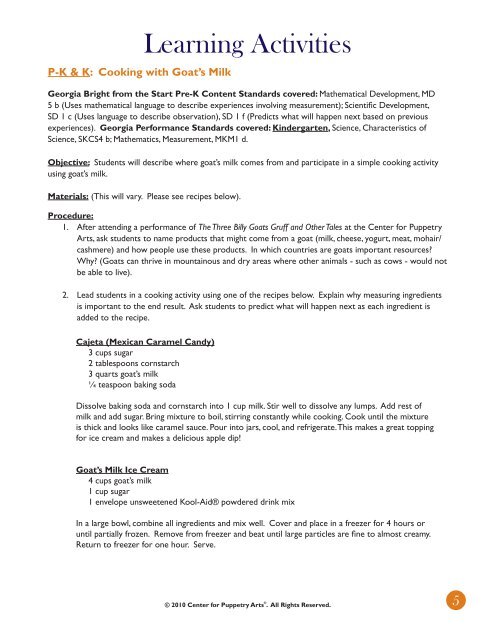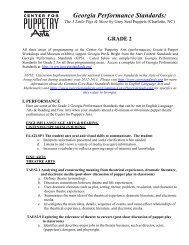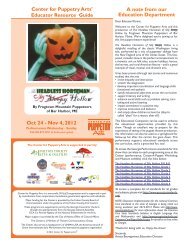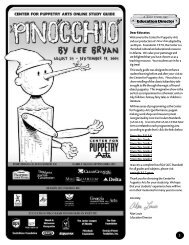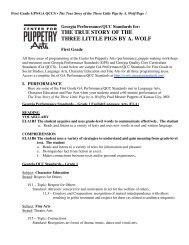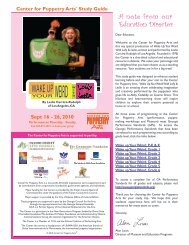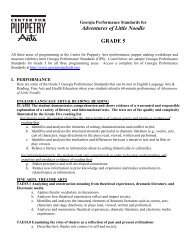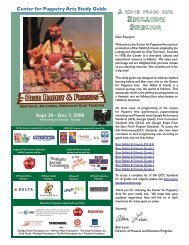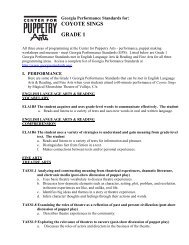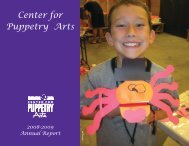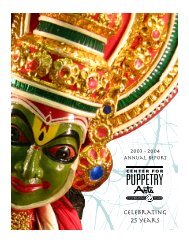Three Billy Goats Gruff and Other Tales - Center for Puppetry Arts
Three Billy Goats Gruff and Other Tales - Center for Puppetry Arts
Three Billy Goats Gruff and Other Tales - Center for Puppetry Arts
Create successful ePaper yourself
Turn your PDF publications into a flip-book with our unique Google optimized e-Paper software.
P-K & K: Cooking with Goat’s Milk<br />
Learning Activities<br />
Georgia Bright from the Start Pre-K Content St<strong>and</strong>ards covered: Mathematical Development, MD<br />
5 b (Uses mathematical language to describe experiences involving measurement); Scientific Development,<br />
SD 1 c (Uses language to describe observation), SD 1 f (Predicts what will happen next based on previous<br />
experiences). Georgia Per<strong>for</strong>mance St<strong>and</strong>ards covered: Kindergarten, Science, Characteristics of<br />
Science, SKCS4 b; Mathematics, Measurement, MKM1 d.<br />
Objective: Students will describe where goat’s milk comes from <strong>and</strong> participate in a simple cooking activity<br />
using goat’s milk.<br />
Materials: (This will vary. Please see recipes below).<br />
Procedure:<br />
1. After attending a per<strong>for</strong>mance of The <strong>Three</strong> <strong>Billy</strong> <strong>Goats</strong> <strong>Gruff</strong> <strong>and</strong> <strong>Other</strong> <strong>Tales</strong> at the <strong>Center</strong> <strong>for</strong> <strong>Puppetry</strong><br />
<strong>Arts</strong>, ask students to name products that might come from a goat (milk, cheese, yogurt, meat, mohair/<br />
cashmere) <strong>and</strong> how people use these products. In which countries are goats important resources?<br />
Why? (<strong>Goats</strong> can thrive in mountainous <strong>and</strong> dry areas where other animals - such as cows - would not<br />
be able to live).<br />
2. Lead students in a cooking activity using one of the recipes below. Explain why measuring ingredients<br />
is important to the end result. Ask students to predict what will happen next as each ingredient is<br />
added to the recipe.<br />
Cajeta (Mexican Caramel C<strong>and</strong>y)<br />
3 cups sugar<br />
2 tablespoons cornstarch<br />
3 quarts goat’s milk<br />
¼ teaspoon baking soda<br />
Dissolve baking soda <strong>and</strong> cornstarch into 1 cup milk. Stir well to dissolve any lumps. Add rest of<br />
milk <strong>and</strong> add sugar. Bring mixture to boil, stirring constantly while cooking. Cook until the mixture<br />
is thick <strong>and</strong> looks like caramel sauce. Pour into jars, cool, <strong>and</strong> refrigerate. This makes a great topping<br />
<strong>for</strong> ice cream <strong>and</strong> makes a delicious apple dip!<br />
Goat’s Milk Ice Cream<br />
4 cups goat’s milk<br />
1 cup sugar<br />
1 envelope unsweetened Kool-Aid® powdered drink mix<br />
In a large bowl, combine all ingredients <strong>and</strong> mix well. Cover <strong>and</strong> place in a freezer <strong>for</strong> 4 hours or<br />
until partially frozen. Remove from freezer <strong>and</strong> beat until large particles are fine to almost creamy.<br />
Return to freezer <strong>for</strong> one hour. Serve.<br />
© 2010 <strong>Center</strong> <strong>for</strong> <strong>Puppetry</strong> <strong>Arts</strong> ® . All Rights Reserved.<br />
5


